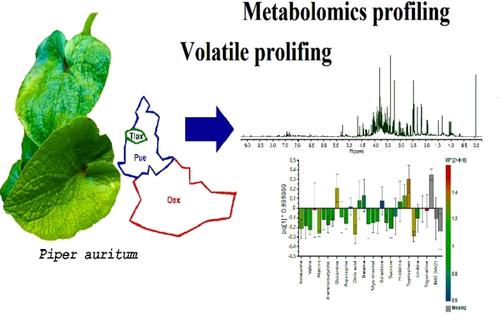当前位置:
X-MOL 学术
›
Chem. Biodivers.
›
论文详情
Our official English website, www.x-mol.net, welcomes your
feedback! (Note: you will need to create a separate account there.)
1H-NMR Metabolomics Profiling and Volatile Content of ‘Hoja Santa’ (Piper auritum Kunth): A Millenary Edible Plant Consumed in Mexico
Chemistry & Biodiversity ( IF 2.3 ) Pub Date : 2022-11-23 , DOI: 10.1002/cbdv.202200667 Yesenia Pacheco-Hernández 1 , Nemesio Villa-Ruano 2 , Ramiro Cruz-Duran 3 , Elvia Becerra-Martínez 4 , Edmundo Lozoya-Gloria 1
Chemistry & Biodiversity ( IF 2.3 ) Pub Date : 2022-11-23 , DOI: 10.1002/cbdv.202200667 Yesenia Pacheco-Hernández 1 , Nemesio Villa-Ruano 2 , Ramiro Cruz-Duran 3 , Elvia Becerra-Martínez 4 , Edmundo Lozoya-Gloria 1
Affiliation

|
The leaves of Piper auritum Kunth (‘Hoja Santa’) have been consumed for centuries by native people of central and southern Mexico as a fresh vegetable or condiment. Herein we present the result of the 1H-NMR metabolomics profiling of three accessions of P. auritum harvested in three different provinces of Mexico (Puebla, Tlaxcala, and Oaxaca). The volatile content associated with the flavoring properties of the plant was also determined by GC/MS. The non-targeted metabolome of these samples revealed that P. auritum is a source of free essential amino acids such as isoleucine, leucine, threonine, valine, histidine, phenylalanine, and tryptophan as well as organic acids, free monosaccharides, and valuable nutraceuticals such as trigonelline, Myo-inositol, betaine, and choline. Principal component analysis and orthogonal partial least squares discriminated analysis of the metabolites found in P. auritum revealed trigonelline as the main differential compound found in the three studied accessions, suggesting this metabolite as a possible chemical marker. According to these statistical approaches, 60 % of the differential metabolites were provided by Oaxaca samples, suggesting that leaves harvested in this province have better (p<0.05) nutritional properties than the other samples analyzed. Nevertheless, the high abundance of the anti-nutrient safrole (90 %) in the volatile fraction, advises the potential toxicity of P. auritum consumed in Oaxaca. On the other hand, samples harvested in the northern highlands of Puebla, contained the lowest levels of safrole (30 %) and acceptable levels of nutrients and nutraceuticals including choline. From the three groups of studied plants, those harvested in the northern highlands from Puebla, could be considered safer for human consumption than the other analyzed accessions.
中文翻译:

“Hoja Santa”(Piper auritum Kunth)的 1H-NMR 代谢组学分析和挥发性成分:墨西哥消费的千年食用植物
几个世纪以来,墨西哥中部和南部的原住民一直将Piper auritum Kunth('Hoja Santa')的叶子作为新鲜蔬菜或调味品食用。在本文中,我们介绍了在墨西哥三个不同省份(普埃布拉、特拉斯卡拉和瓦哈卡)收获的三个金紫杉种质的1 H-NMR 代谢组学分析结果。与植物风味特性相关的挥发物含量也通过 GC/MS 测定。这些样本的非靶向代谢组显示P. auritum是游离必需氨基酸(如异亮氨酸、亮氨酸、苏氨酸、缬氨酸、组氨酸、苯丙氨酸和色氨酸)以及有机酸、游离单糖和有价值的营养保健品(如葫芦巴碱、肌醇、甜菜碱和胆碱)的来源。在P. auritum中发现的代谢物的主成分分析和正交偏最小二乘法判别分析显示葫芦巴碱是三个研究种质中发现的主要差异化合物,表明该代谢物可能是一种化学标记物。根据这些统计方法,瓦哈卡样品提供了 60% 的差异代谢物,这表明在该省收获的叶子具有更好的(p<0.05) 营养特性优于分析的其他样品。然而,挥发性部分中高丰度的抗营养黄樟素 (90%) 表明在瓦哈卡州消费的P. auritum具有潜在毒性。另一方面,在普埃布拉北部高地采集的样本含有最低水平的黄樟素 (30%) 和可接受水平的营养素和保健品,包括胆碱。在所研究的三组植物中,从普埃布拉北部高地收获的植物被认为比其他分析的植物更安全供人类食用。
更新日期:2022-11-23
中文翻译:

“Hoja Santa”(Piper auritum Kunth)的 1H-NMR 代谢组学分析和挥发性成分:墨西哥消费的千年食用植物
几个世纪以来,墨西哥中部和南部的原住民一直将Piper auritum Kunth('Hoja Santa')的叶子作为新鲜蔬菜或调味品食用。在本文中,我们介绍了在墨西哥三个不同省份(普埃布拉、特拉斯卡拉和瓦哈卡)收获的三个金紫杉种质的1 H-NMR 代谢组学分析结果。与植物风味特性相关的挥发物含量也通过 GC/MS 测定。这些样本的非靶向代谢组显示P. auritum是游离必需氨基酸(如异亮氨酸、亮氨酸、苏氨酸、缬氨酸、组氨酸、苯丙氨酸和色氨酸)以及有机酸、游离单糖和有价值的营养保健品(如葫芦巴碱、肌醇、甜菜碱和胆碱)的来源。在P. auritum中发现的代谢物的主成分分析和正交偏最小二乘法判别分析显示葫芦巴碱是三个研究种质中发现的主要差异化合物,表明该代谢物可能是一种化学标记物。根据这些统计方法,瓦哈卡样品提供了 60% 的差异代谢物,这表明在该省收获的叶子具有更好的(p<0.05) 营养特性优于分析的其他样品。然而,挥发性部分中高丰度的抗营养黄樟素 (90%) 表明在瓦哈卡州消费的P. auritum具有潜在毒性。另一方面,在普埃布拉北部高地采集的样本含有最低水平的黄樟素 (30%) 和可接受水平的营养素和保健品,包括胆碱。在所研究的三组植物中,从普埃布拉北部高地收获的植物被认为比其他分析的植物更安全供人类食用。











































 京公网安备 11010802027423号
京公网安备 11010802027423号